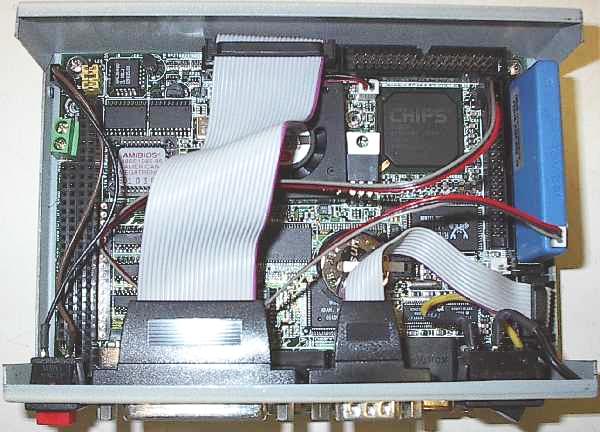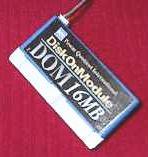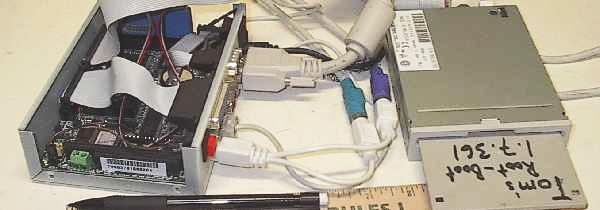Article: Hacking the TCSX-1 for fun and profit
Dec 12, 2001 — by LinuxDevices Staff — from the LinuxDevices Archive — 8 viewsGetting to know the TCSX-1
They say good things come in small packages. Advantage Business Computer Systems' TCSX-1 Thin Client is one of those good things. Add a keyboard, mouse and VGA monitor to this little box and you have a simple Network, Serial or X Windows terminal. And, if within your chest beats a techie's heart, you'll also have loads of fun taking the TCSX-1 apart to see what makes it tick.


What's inside?
Inside the 6-1/8 x 4-1/2 x 1-3/4 in. surface-mountable box you'll find . . .
- A PC/104-expandable “embedded PC” motherboard — probably the most expensive part of the whole system, this motherboard is quite small. It has a connector for a DiskOnChip flash module, but it's empty in Advantage's design.
- AMI BIOS
- 75MHz STPC Processor — essentially a 75MHz '486, this processor is a bit underpowered for some applications, but it provides more than enough horsepower for Advantage's Thin Client application.
- 16 Megabytes of RAM
A 16 Megabyte DiskOnModule (DOM) — this cool little device essentially is 16 megs of flash memory stuck on the end of a IDE cable with some logic that make it look like an IDE drive. The only drawback is the size of the unit. It sticks up almost another inch above the connector — this might be a problem for some applications. The TCSX-1 box is tall enough, so no problem here. If you were using it in an application, it could be moved with a short piece of ribbon cable.

External connections
Coming out the back of the TCSX-1 are . . .
- Reset and power switches — 5 volts, DC. The big red didn't-mean-to-hit-it reset switch disappears in the next revision of the product.
- Two serial Ports — back in the stone age, before we all had real computers on our desks and had to connect to “The Computer” through serial connections using our dumb terminals, we all dreamed of having two serial connections. Well, now you have them. If you've left the stone age and now use an Ethernet network, then these two serial connectors do not go to waste. One can be used for a bar code scanner, and the other can be used for a serial printer.
- A parallel port — the TCSX-1 software shares the parallel port (and presumably the printer attached to it) to the network using the p910nd software.
- A VGA connector
- A single Ethernet connector
- A single keyboard/mouse DIN connector
Installation
Installation couldn't be much easier! Plug in the keyboard, mouse, VGA, and Ethernet, and turn the box on. It will ask you whether you want it to be a Serial, Network, or X terminal. I chose Network. After configuring the network, you are presented with a screen that allows you to press return to connect to your server.
Using the TCSX-1
Once you're connected to your server, you use the TCSX-1 just like any other terminal. Type characters into it and get responses out. Even though I didn't try the X terminal, I expect it works like any other X terminal — nice graphical output from your server on your desktop.
Hacking the TCSX-1
Now for the fun part; hacking into the TCSX-1 to see what makes it tick.
At first I thought I could just hack into it using some sort of shell trick. Knowing that when it is in Setup mode it's running a shell script that does a shell “read” followed by some sort of shell “if [ ]; then” sequence, I thought I could just give it some magic ASCII shell escape sequence to get myself to the shell. No such luck. I did manage to get the shell script to barf error codes several times, but that was the best I could do. Time to break out the screw driver and do it the hard way.

Once I had it apart, I figured that I could just plug the DiskOnModule into the secondary IDE of my scratch PC's motherboard. Again no luck. For some reason my scratch PC wouldn't recognize the DOM as a hard drive. I tried it both with and without using the TCSX-1 as the power supply for the DOM. So, if I was going to see what was on the DOM, I was going to have to keep it plugged into the TCSX-1. Fortunately, the motherboard inside the TCSX-1 has a floppy drive connector. After connecting a spare floppy drive and fiddling with the BIOS a bit, I was able to boot Toms Root Boot — “The most GNU/Linux on 1 floppy disk.”
Once booted, I mounted /dev/hda1 and /dev/hda2 from the DOM onto /1 and /2. Now looking at what the TCSX-1 is doing is easy enough. Searching through the various /etc/rc.* scripts, I found that the backdoor to the shell prompt is “abcssupport”. Also, like any good embedded Linux device, the TCSX-1 uses Busybox for most of its shell commands.
The good points
- A highly functional, stable, almost solid state computer that's just a little bigger than a 3 1/2 floppy drive.
- 16MB of RAM + 16MB of flash is plenty for a lot of applications.
- The software that's included is solid and functional. Anyone trying to build their own embedded Linux device would do well to study how Advantage put the TCSX-1's software together.
Nits
- In addition to telnet, ssh would be nice.
- There is practically no documentation for the product. To be fair, the TCSX-1 wasn't meant to be a product that one buys off-the-shelf. Advantage builds them to sell to their vertical market customers.
- 75MHz 486 is cutting it pretty thin, processor-wise, for many applications.
- At $400, this box is really pricey for what you get. Unfortunately, this is just the way it is in the embedded-PC world. If someone could put a box this size together and sell it without software for less than $100, they'd sell them by the truckloads.
Availability
The TCSX-1 is available from http://www.disklessworkstations.com.
About the author: John Lombardo has been working with Linux since the “0.9” days. However, he does remember downloading a very early version and thinking: “Yeah, right — how is this Linux thing going to compete with Coherent” (an early 1990's Unix clone from The Mark Williams Company). Lately, John has been working on several embedded Linux projects, including easy-to-use IPSEC routers, ARM7-based NAT routers, and a book called Embedded Linux published by New Rider's Publishing. You can reach John at [email protected].
This article was originally published on LinuxDevices.com and has been donated to the open source community by QuinStreet Inc. Please visit LinuxToday.com for up-to-date news and articles about Linux and open source.